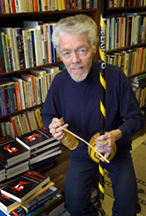
March 17, 2005
Prof promotes African-Brazilian dance, sport of Capoeira
WEST LAFAYETTE, Ind. – A Purdue University Spanish professor says the best way to understand the African-Brazilian influenced Capoeira is by comparing its deceptive elements to what it is not – dance, martial arts or gymnastics.

|
"There is nothing in English to describe Capoeira, which looks like a scrappy, ritualized ballet that challenges the performers' physical and mental abilities," says Floyd Merrell, who studies and practices Capoeira (pronounced KA puer AH). "Even more than 100 years after slaves used Capoeira to deceive their slave owners, the ideas of deception are still part of the movement today."
Capoeira is usually performed in a circle, which is outlined by a ring of people. Some of the participants play traditional African instruments, such as the bow-shaped berimbau. The traditional form of Capoeira, called Capoeira Angola, is a non-contact activity in which performers move to music by flipping, somersaulting and kicking. Basic moves are practiced, but performances are always improvised, Merrell says.
"The performance looks like play, but it is serious," he says. "It's a labyrinth of contradictions. It is not a religion, but has religious attitudes and symbols on its instruments and costumes, as well as in its movements."
Capoeira is a fusion of physical, mental and spiritual activity influenced by Brazilian, African and Native American traditions, writes Merrell in his new book. "Capoeira and Candomblé: Conformity and Resistance through Afro-Brazilian Experience" ($69.95 hardback and $24.95 paperback) was released in January by Markus Wiener Publishers.
Candomblé is a hybrid religion combining Catholic and African religious beliefs and practices in Capoeira. Merrell, who researched Capoeira and Candomblé in the Portuguese language, says this is the first book in English to profile the history and philosophy of Capoeira and compare it to Candomblé.
"Capoeira can be called a form of art and a sport, but it is really a relic of the effects of European colonization of the Americas and the importing of African slaves," he says.
Capoeira began with African slaves who were brought to Brazil in the 17th century, Merrell says. In Africa, Capoeira was an Angolan ritual that had many religious connotations. On the Brazilian plantations, it became a cover so slaves, who were not allowed to own weapons or to exercise by fighting, could practice self-defense under the guise of dance.
Brazil was the last Western country to abolish slavery in 1888. However, practicing Capoeira became a crime, and through the 1930s performers were arrested and sometimes killed. The Brazilian ruler Getulio Vargas relaxed the laws about Capoeira, allowing people to practice without being persecuted.
At the same time, two forms of Capoeira emerged from Salvador, Brazil, a large city on the east coast. The Angolan form, supported by Vicente Ferreira Pastinha, tried to conserve the movements and music associated with early 17th century Capoeira. Manoel dos Reis Machado created the regional form that emphasizes discipline by integrating more martial art moves. Angola performances often are slower than the acrobatic regional style.
"Both of these Capoeira masters are responsible for formalizing training, as well as preserving and influencing what we know as Capoeira today," says Merrell, who practices the Angola form. "Even the aspect of deception is still a part of performances today."
For example, a performer will try to bait another performer with moves, similar to a martial arts match. Or someone may act like they hurt themselves while cartwheeling. In Brazil, someone will enter the ring as a novice, but really he or she is a disguised master, Merrell says. Often, deception is included to introduce humor into the performance, Merrell says.
Capoeira is now becoming more popular around the world, especially in South American countries, Japan and American cities, such as New York City and Miami. Merrell is the faculty adviser for Purdue's Capoeira Club.
Merrell is the author of 25 books, including "Living Learning, Learning Living: Signs, East and West." He studies semiotics, Latin American cultures and Spanish-American literature. Next, Merrell plans to interview the 106-year-old father of one of the Capoeira master's in Brazil to chronicle his personal history.
Merrell's work is supported by Purdue's Department of Foreign Languages and Literatures, which is housed in the College of Liberal Arts.
Writer: Amy Patterson-Neubert, (765) 494-9723, apatterson@purdue.edu
Source: Floyd Merrell, (765) 496-2265, fmerrell@purdue.edu
Purdue News Service: (765) 494-2096; purduenews@purdue.edu
PHOTO CAPTION:
Floyd Merrell, professor of Spanish, shows the berimbau, a bow-shaped instrument that is played during Capoeira performances. Capoeira is a non-contact, African-Brazilian influenced activity in which performers move to music by flipping, somersaulting and kicking. Merrell is the author of "Capoeira and Candomblé: Conformity and Resistance through Afro-Brazilian Experience." Capoeira was brought to Brazil in the 17th century by African slaves and was a way for them to practice self-defense under the guise of music, dance and gymnastics. (Purdue News Service photo/David Umberger)
A publication-quality photograph is available at https://ftp.purdue.edu/pub/uns/+2005/merrell-capoeira.jpg.
To the News Service home page